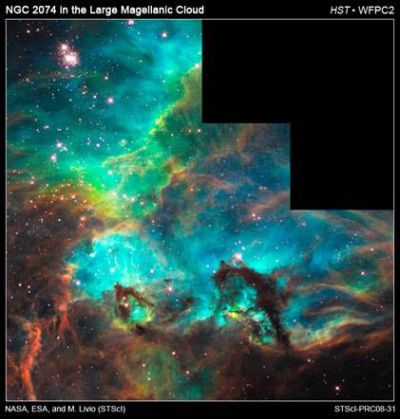12 August 2008

Celebrating the 100,000th orbit of NASA's Hubble Space Telescope (HST), scientists at the Space Telescope Science Institute (STScI), have slewed Hubble to picture a distant, dazzling star birth region.
Hubble peered into a small portion of the nebula near the star cluster NGC 2074 (upper, left). The region features an energetic star formation process, perhaps stimulated by a nearby explosion of a massive star (supernova). It lies about 170,000 light-years away, in a nearby companion galaxy, known as the Large Magellanic Cloud (LMC). A gigantic brilliant nebula, known as the Tarantula Nebula, is also located near NGC 2074.
This representative color image was taken on 10 August 2008, with HST's Wide Field Planetary Camera 2. Red shows emission from sulfur atoms, green from glowing hydrogen, and blue from glowing oxygen.
The exquisite image reveals magnificent structures of cosmic dust and gaseous filaments, glowing under intense ultraviolet radiation. The region is on the edge of a dark molecular cloud containing the raw material for star formation, a stellar nursery.
Clusters of hot young stars already born within NGC 2074 emit fierce ultraviolet radiation, gradually eroding the nebula. A young cluster may lie beyond a circle of brilliant gas at center, bottom.
Further Reading
Hubble Site
http://hubblesite.org/
Aymen Mohamed Ibrahem
Senior Astronomy Specialist